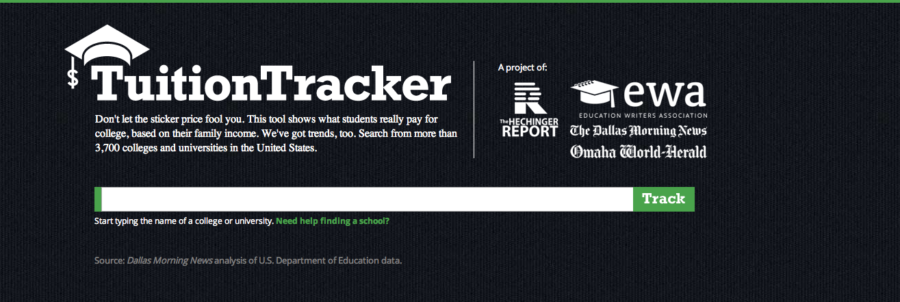The real cost of college
Tuution Tracker is one of the many platforms that help students get a more accurate understanding of the cost of college
May 1, 2014
College is expensive. The thought of snowballing fees can put many parents and students alike on edge. However, with financial aid, estimated tuition and overall costs are often much lower than advertised thanks to scholarships.
Depending on many things such as family income, siblings expected to go to college, or other factors that may affect a family’s ability to pay, colleges often consider providing aid to students. However, students from high income households are sometimes expected by universities to pay most or all of their tuition.
“It’s part of a murky system in which wealthier students subsidize lower-income classmates, out-of-state students subsidize in-state ones, humanities majors subsidize science majors, freshmen and sophomores subsidize juniors and seniors, and international students subsidize everyone,” the Dallas Morning News wrote in a special series of articles on the cost of college.
The ability of a family to subsidize others through this system is evaluated universally. Free Application for Federal Student Aid (FAFSA) is a universal application that evaluates the Estimated Family Contribution (EFC). FAFSA is used by many universities to determine how much a family can actually pay, therefore the cost of college is variant depending upon a family’s situation.
Most students, especially those in lower income brackets, have many scholarships available to them, making the fees for colleges generally a lot lower than they appear.
“Often times the price that a parent or a student may see is like the sticker price you may see on a car window at a dealership. It’s not necessarily the price you pay. Scholarships are kind of like rebates, depending on a student’s financial situation, they may be eligible for some need based aid and academic scholarships. So that dollar number that you see, is not always the price that you pay,” college and career counselor Randy Trevino said. “Colleges now a days are trying to be more forthright with the total cost of college, so it’s kinda of a shock value, but it’s not necessarily the price you pay. For example of SMU, the shock value total cost was approaching sixty thousand dollars a year, when I worked there. Between tuition, room and board books, fees, everything. However, the average student at SMU received twenty four thousand dollars between academic scholarships and need based financial aid. So that’s a pretty significant discount, it’s not every student, some students got more money than that, actually.”
Public universities, especially for in-state residents, tend to be less expensive than their private competitors. A survey showed that a moderate college budget for an in-state public college for the 2013–2014 academic year averaged $22,826, while a moderate private college averaged $44,750.
Due to the funds offered by the state to public colleges, they tend to be less expensive for in-state students. However, often times private colleges offer more scholarship opportunities in an effort to offset the hefty costs.
Some websites, like TuitionTracker, are designed to estimate the price of college for students. However, the prices are just estimates but these websites may provide a more realistic idea of the true cost of college. Additionally, there are a plethora of scholarships available to students, regardless of their prospective college.
Besides scholarships, there is another, and often times much more feared method of paying for college. Student loans are often demonized due to the lasting effect they can have on a student’s credit. However, if a student has no other means, they can be one of the best ways to allow a student to pursue a higher education.
“If a student is taking fifty thousand dollars worth of loans out of four years, that would raise some pretty big red flags, it would depend on the situation, but especially if the student has intentions to go to grad school later on,” Trevino said. “However, if a student can take out a reasonably modest amount of student loans, that’s not a bad thing at all, especially if a student can take advantage of subsidized loans where the interest rates are very low, and they can even write off the interest when they pay their taxes each year. A modest amount [of loans] is not a bad thing, it’s when you get into the really high dollar amounts per year, a student can find themselves awash with debt once they graduate.”
Although college may seem like a massive cost, with subsidies and other methods, college can be more affordable than it appears.
“The price you see isn’t always the price you pay,” Trevino said. “With rising tuition and cost, generally you’ll see some kind of reasonable match with scholarships or some kind of financial aid.”




